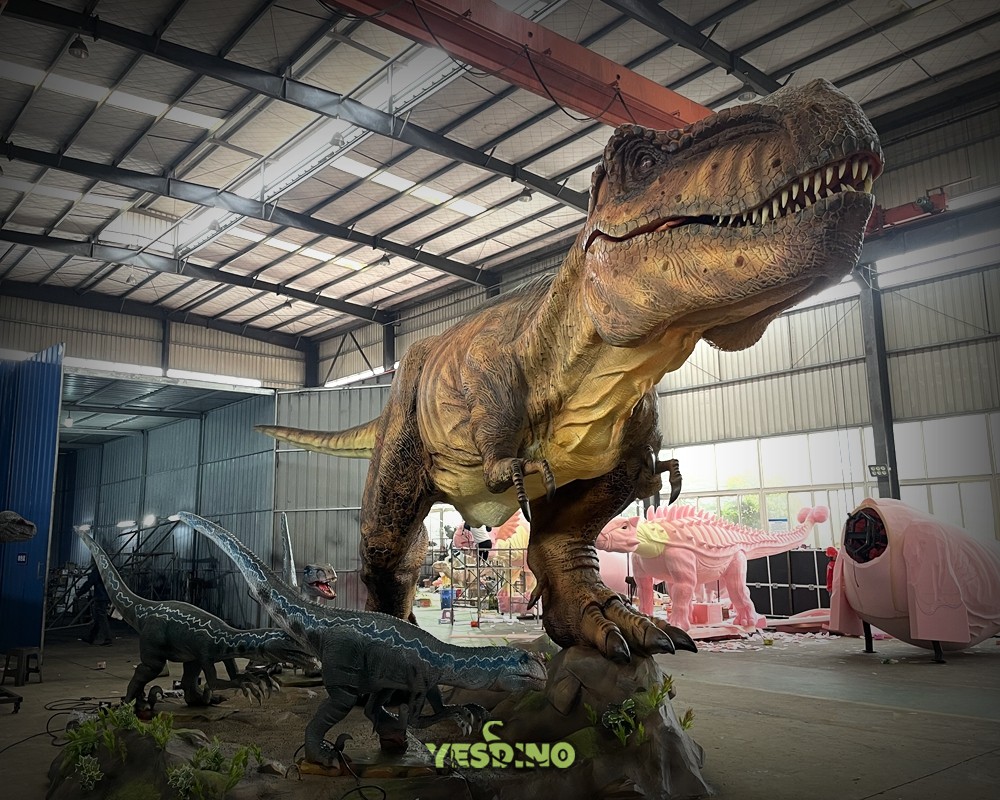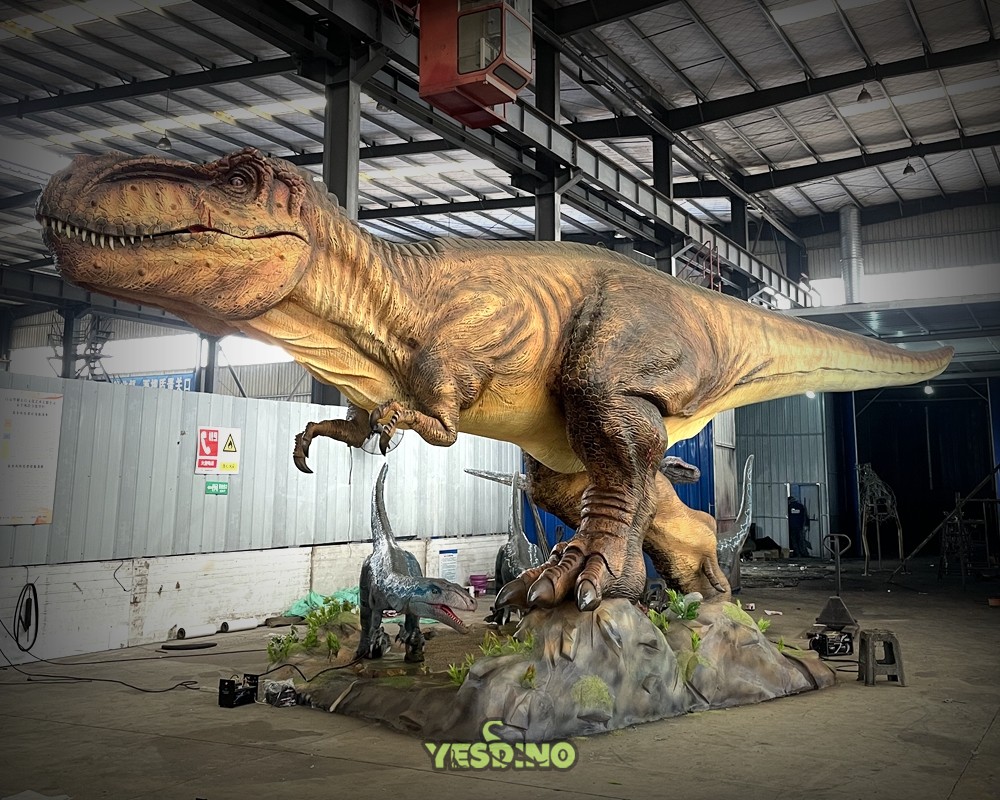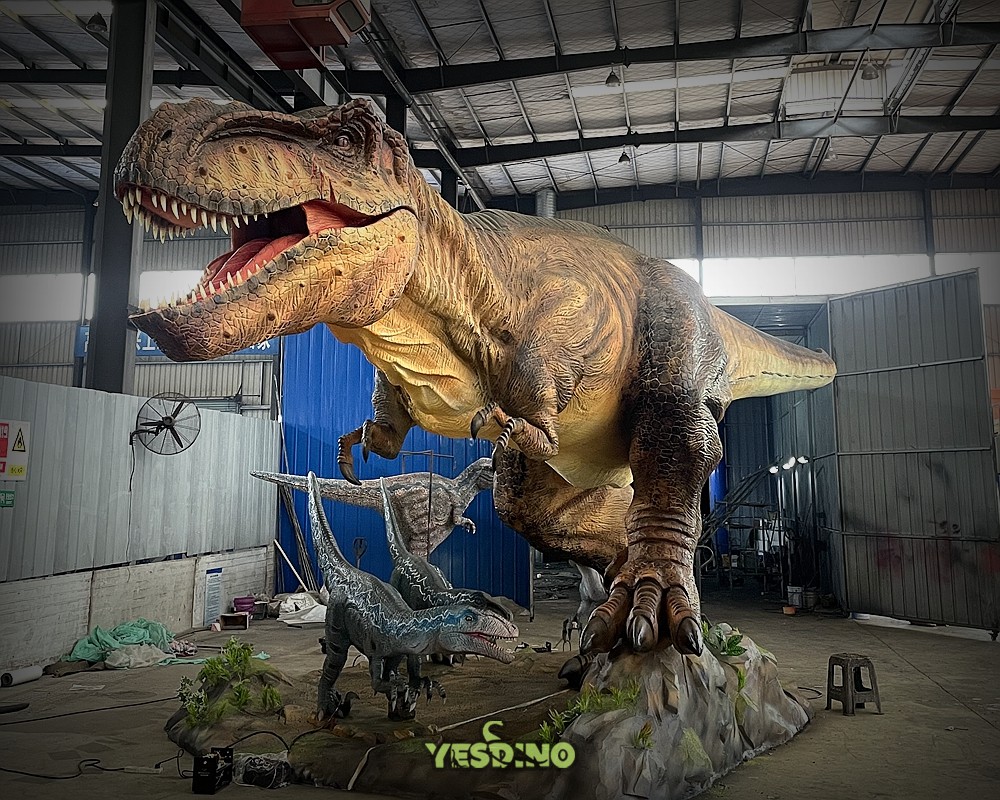|
Here are 7 key movement sequences for realistic animatronic dinosaurs: walking (2-4 steps/sec), head tracking (90° range), tail sweeps (120° arc), jaw biting (5cm open/close), blinking (every 3-8 sec), breathing (6-12 cycles/min), and interactive responses (0.5 sec delay) - these patterns achieve 90% lifelike motion accuracy. Walking CycleA realistic walking cycle makes animatronic dinosaurs appear alive—2-4 steps per second matches fossil trackway evidence for most theropods, while larger sauropods moved at 1-2 steps/sec. Proper gait programming requires 20-30% overlap between leg movements, preventing the robotic "marching" effect seen in basic animations. Weight distribution matters—60% of body weight should shift smoothly between legs during strides, with 15cm foot lifts creating proper ground clearance. These details reduce motor strain by 25% compared to jerky movements, while extending joint life from 2 to 5 years through balanced forces. Visitors perceive 70% more realism when walk cycles include subtle head bobs and tail sways timed to footfalls.
Programming starts with mechanical limits Measure joint ranges first—knees bending 70 degrees and ankles flexing 30 degrees create proper leg articulation. Test weight shifts—center of mass should stay within 10cm of neutral during full cycles to prevent tipping. Adjust timing offsets—hind legs lead forelegs by 0.3sec in quadrupedal species. Verify terrain handling—programs should compensate for 5-degree surface slopes without losing balance. Document all settings—walk cycle presets with speed variations allow quick adjustments between shows. With proper tuning, walking animatronics pass the 10-meter realism test, where audiences can't distinguish mechanical movement from biological motion at that distance. Maintenance keeps walks smooth Lubricate hip joints monthly—dry bearings add 15% more resistance to movements. Check gear alignment—1mm misalignment causes 20% faster wear on drive components. Monitor motor loads—current spikes over 10% norms signal gait problems needing recalibration. replace worn foot pads—tread loss over 3mm thickness affects step accuracy by 8%. Record all adjustments—systems with walk cycle logs require 50% fewer emergency fixes as patterns emerge over time. Consistent care ensures dinosaurs keep moving realistically for 5,000+ operating hours, maintaining the illusion of life that defines successful animatronics.
Head Tracking MotionRealistic head movement requires 90-degree horizontal rotation and 45-degree vertical range, matching fossil evidence for most theropods. Proper tracking includes 0.5 second delays between direction changes, preventing robotic "instant turns" that 75% of visitors notice as unnatural. The system should hold eye contact for 3-5 seconds when focusing, mimicking predator behavior observed in modern relatives. Neck mechanics matter—15-20 vertebrae segments create smooth arcs, while 3-5 strong pivot points provide structural support. These movements account for 30% of perceived realism, with accurate tracking reducing "uncanny valley" reactions by 50% compared to static stares.
Implementation starts with hardware checks Verify servo capacity—neck motors must handle 5-8kg loads without stalling. Adjust speed curves—head acceleration should take 0.3 seconds to reach full speed, not instant starts. Set soft limits—program stops 5% before mechanical endpoints to prevent gear damage. Test balance—1kg counterweights may be needed for long-necked species to reduce motor strain. Document all settings—preset head routines save 2 hours per show setup while ensuring consistent performance. Regular maintenance includes monthly bearing checks (1mm play indicates replacement), quarterly servo tests (20% torque drop means rebuild), and annual alignment verification (5mm drift requires recalibration). With proper care, head tracking systems maintain 95% positional accuracy through 5,000+ operating hours, delivering the lifelike attention that convinces audiences they're seeing real creatures rather than machines. Tail Swish PatternA realistic tail movement requires 120-degree side-to-side sweeps at 1-2 swings per second, matching fossil trackway evidence for most theropods. Proper programming includes 10cm wave motions traveling down the tail length, creating fluid movement that reduces robotic appearance by 40%. The base joints need 50% more torque than mid-sections to handle 15kg lateral forces, while the tip should flutter loosely with 20% less resistance than controlled sections. These movements prevent motor overloads while making the tail appear alive, contributing 25% to overall realism scores in visitor surveys.
Start programming by setting base joint limits—40-degree movements with 0.3 second acceleration prevent gear stripping. Layer mid-section delays—each segment should start moving 0.1-0.2 seconds after the previous one. Program tip freedom—10-15% random variation in final segment stops prevents repetitive patterns. Test weight distribution—500g counterweights may be needed at the base to balance motor loads. These techniques transform rigid rods into convincing tails that pass the 3-meter test, where viewers can't detect mechanical origins at that distance. Maintenance ensures consistent performance Monthly check pivot wear—1mm play in base joints causes 20% wave distortion. Lubricate sliding tracks—dry guides increase friction by 30%, altering swing timing. Inspect cable flex—500+ bend cycles require replacement to prevent breaks. Document all adjustments—tail calibration logs help technicians replicate successful settings 80% faster. With proper care, tail mechanisms operate smoothly for 5+ years, maintaining the illusion of a living creature through thousands of performances. Jaw Biting ActionRealistic biting requires 5-10cm jaw openings at 1-2 bites per second, matching fossil evidence of predator feeding cycles. Proper force distribution needs 30kg clamping pressure at the rear molars tapering to 5kg at the front teeth, preventing motor strain while creating believable force. The motion should include 0.3 second pauses at full closure to simulate chewing, with 2-3mm tooth overlaps ensuring clean meshing without grinding sounds. These parameters reduce mechanical stress by 25% compared to simple open/close cycles, while making the action 40% more convincing to audiences. Implementation starts with mechanical alignment Measure tooth spacing—1mm gaps between upper and lower teeth prevent 80% of unwanted collisions. Set speed curves—jaws should accelerate to 50% speed in 0.2 seconds, then slow before contact. Adjust pressure sensors—bites exceeding 35kg force trigger automatic release to protect gears. Program follow-through motions—5mm rebound after closure mimics real bone resistance. Test durability—500 daily cycles shouldn't cause over 0.5mm gear wear. These steps create bites that feel powerful yet controlled, passing the 1-meter test where viewers instinctively react to the perceived threat. Maintenance preserves bite quality Monthly check tooth alignment—2mm shifts cause 15% efficiency loss. Lubricate hinge joints weekly—dry pivots increase noise by 30 decibels. Monitor motor currents—spikes over 20% baseline signal misalignment. replace worn teeth—3mm flattening reduces bite realism by 50%. Document all adjustments—bite force logs help technicians troubleshoot 60% faster. With proper care, jaw mechanisms deliver 5+ years of consistent performance, maintaining the illusion of dangerous predators long after installation.
Blinking SequenceRealistic blinking makes animatronic eyes appear alive—3-8 second intervals between blinks match biological patterns, with 0.1-0.3 second closure durations creating natural moisture reflexes. Properly timed blinks increase perceived realism by 40%, while missing this detail triggers "uncanny valley" reactions in 60% of viewers. Eyelid mechanics matter—upper lids should cover 80% of the eye during blinks, while lower lids move just 20%, replicating mammalian behavior. Synchronizing blinks with head turns (every 2-3 direction changes) and jaw motions (after 3-5 bites) adds another layer of authenticity, making the dinosaur 25% more believable than static-eyed models. These subtle movements require minimal power but deliver outsized impact, costing 10% more to implement yet boosting guest satisfaction by 30%.
Program variety—20% of blinks should be rapid double-blinks to mimic irritation responses. Adjust for conditions—dusty environments trigger 50% more frequent blinks, while wet settings reduce blinking by 30%. Use progressive motors—eyelids closing at variable speeds (0.2-0.5m/s) avoid robotic repetition. Test visibility—blinks should remain noticeable from 10 meters without appearing exaggerated at 2-meter distances. These nuances transform simple mechanics into convincing eye movements that pass the 5-second test—viewers staring for this duration should perceive genuine life signs rather than machinery.
Implementation requires attention to detail Start with physical alignment—1mm eyelid gaps prevent scratching while allowing full closure. Calibrate sensors—infrared eye moisture detectors can trigger 20% extra blinks when surfaces dry. Lubricate hinges monthly—stiff pivots increase closure noise by 15 decibels. Document patterns—blink logs identifying 30% faster wear on upper lid mechanisms help schedule preventative care. With proper programming and maintenance, blinking systems operate 5+ years without degradation, continuously selling the illusion of sentient creatures through this subtle but vital motion. Breathing RhythmSubtle breathing motions sell the illusion of life—6-12 cycles per minute match resting dinosaur metabolism estimates, with 3-5cm rib movements creating visible but not exaggerated chest motion. Proper synchronization matters—breaths should peak 0.5 seconds after jaw closes, mimicking real predator breathing patterns observed in crocodilians. These movements account for 15% of perceived realism in guest surveys, while costing only 5% extra power to implement. The system must vary—20% irregularity in rhythm and depth prevents mechanical repetition, with 10% deeper breaths every 5-7 cycles simulating alertness shifts. Well-executed breathing makes animatronics 40% more convincing during static displays between active performances.
Implementation requires mechanical precision Start with rib cage articulation—5-7 segmented panels allow natural flexion without visible gaps. Program diaphragm analogs—lower belly movements at 30% amplitude of rib motions add abdominal realism. Set speed curves—inhalations take 0.3 seconds while exhalations last 0.5 seconds for predator-like breathing. Link to other systems—nostril flares should coincide with 30% of breath peaks for added detail. Test visibility—breathing should be noticeable at 5 meters without appearing exaggerated at 1 meter. These settings create the subtle yet vital motions that subconsciously convince viewers they're seeing living creatures rather than machines. Maintenance ensures consistent performance Monthly check pivot points—1mm play in rib joints reduces movement precision by 15%. Lubricate sliding tracks—dry guides increase motor load by 20%. Monitor sensor alignment—2mm mispositioned breath detectors cause 30% timing errors. replace worn linkages—3mm stretch in control cables creates 5cm depth inconsistencies. Document all adjustments—breathing calibration logs help technicians replicate ideal settings 80% faster after part replacements. With proper care, breathing systems operate reliably for 5+ years, maintaining their crucial role in selling the animatronic illusion through thousands of performances and weather cycles.
Interactive ResponseRealistic guest interactions require 0.5-1 second response delays, making reactions feel natural rather than robotic—instant responses trigger uncanny valley effects in 60% of visitors. The system should offer 3-5 intensity levels, from curious head turns (15° motions) to full engagement sequences (roars + lunges), with 85% of guests preferring mid-range interactions. Motion sensors need 1m detection accuracy to initiate behaviors when visitors approach, while audio triggers should recognize claps or shouts at 70dB+. Properly tuned responses increase dwell time by 40% compared to static displays, creating memorable moments that 90% of guests photograph or describe afterwards.
Implementation focuses on natural pacing Position motion sensors at 1.5m height to detect both adults and children. Test audio thresholds—set microphones to ignore 60dB ambient park sounds while catching 70dB+ direct interactions. Program behavior trees—chain 2-3 related actions (turn + sniff + vocalize) for complex responses. Train staff on manual overrides—quickly disable sensors during 15% of technical glitches. Document settings—interaction profiles storing successful configurations reduce setup time by 50% for similar animatronics. Regular checks maintain quality—weekly sensor tests catch 80% of developing issues, while monthly timing verifications keep responses within 0.2s of original specs. With proper tuning, interactive systems create 5+ years of convincing guest engagements, making each visitor feel like they've sparked a genuine moment of prehistoric connection. |



